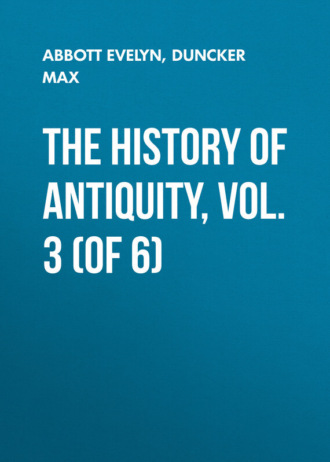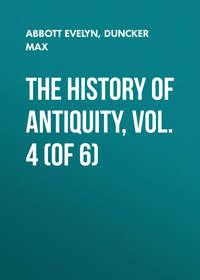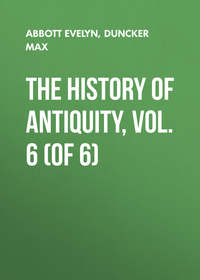 полная версия
полная версияThe History of Antiquity, Vol. 3 (of 6)
525
Aristoph. Aves, 102.
526
Hellan. Frag. 158. Callisth. Frag. 32, ed. Müller.
527
Movers, "Relig. der Phœniker," s. 154. 394, 465, 496, 612. The pyre which Alexander caused to be erected in Babylon to Hephæstion, after the Semitic pattern, was four stades in circuit and 200 feet in height. Diod. 17, 115.
528
Aristob. Frag. 6, ed. Müller. Cf. above, p. 145, 146.
529
e. g. Diod. 2, 24; Amyntas in Athenæus, p. 529.
530
If we assume that the 28 years of the Scythian dominion have already been deducted from the 128 years, and must therefore be added to them, 714 B.C. (= 558 + 156) is the beginning of the Median dominion. In the other case this must have commenced in the year 658 (558 + 100) B.C. Since Herodotus represents Phraortes as first conquering Asia, and represents him as ascending the throne in 655 B.C., the duration of the Median empire is not even 100, but only 79 years. We shall soon see that it was even shorter.
531
Deioces reigned 53 years, Phraortes 22, Cyaxares 40, Astyages 35. Each pair of rulers makes up a total of 75 years.
532
Zeph. i. 1.
533
Jerem. i. 1; xxv. 3.
534
Jerem. iv. 6.
535
Jerem. vi. 1.
536
2 Maccab. xii. 29. Strabo, p. 763; Joseph. "Antiq." 5, 1, 22, etc. Pliny, "Hist. Nat." 5, 16; Steph. Byzant. Σκυθόπολις.
537
Justin, 1, 2-5.
538
Syncell. "Chron." p. 405, ed. Bonn.
539
Herod. 1, 6, 15, 16.
540
Hippocr. "De aero," c. 22.
541
"Ethic. Nicom." 7, 7 (8).
542
Vol. V., chap. 3.
543
Above, p. 164.
544
Nahum iii. 8.
545
Nahum ii. 13, 14; iii. 1-5, 12-15.
546
Nahum i. 8, 14; iii. 7-12; iii. 7, 13.
547
Zeph. ii. 13-15.
548
In Polyhistor Sardanapalus reigns over the Chaldæans for 21 years after Samuges.
549
In Athenæus, p. 553.
550
Euseb. "Chron." 1, p. 37, ed. Schöne. Kiepert, "Monatsb. B. A.," 1873, s. 191.
551
Syncell. "Chron." p. 210, ed. Bonn.
552
Asdahag is the Armenian form in the Armenian Eusebius.
553
As we have the choice between the two eclipses of 610 and 584 B.C. the preference must be given to that of 610 B.C. Where the battle was fought between the Medes and Lydians we do not know; but we do know that in the year 584 B.C. Cyaxares and Nabopolassar were no longer alive. If we replace these names by Astyages and Nebuchadnezzar – although the children of the princes who conclude peace and alliance are expressly named as the parties contracting in marriage – and Astyages had no son, Nineveh had fallen long before 584B.C., and Babylonia would not have had the least interest in bringing about a peace between Lydia and Media. On the contrary, Nebuchadnezzar, who had erected such enormous fortifications against Media, in order to secure his own weaker kingdom against any attacks of the Median power, would only have been too glad to keep Media engaged in the West by the continuance of the Lydian war. Yet that it was a question of the rescue of Lydia in the interest of Babylonia cannot be supported in the face of the assertion of Herodotus, that the fortune of arms was equal. As the dates given by Herodotus for the reigns of the Lydian kings have to be replaced by those of Eusebius (below, Chapter 17), the dating of the beginning of the war at the year 615 B.C. would allow the first three years to fall in the reign of Sadyattes; but in this there is no difficulty.
554
E. Schrader, "K. A. T.," s. 233.
555
G. Smith, "Disc.," p. 344.
556
G. Smith, loc. cit. p. 382.
557
G. Smith, loc. cit. p. 382.
558
Sayce, "Babylon. Litterature," p. 79, seqq.
559
"Anab." 3, 4, 7-9.
560
Euseb. "Chron." I., p. 37, ed. Schöne.
561
Syncell, "Chron." p. 396, ed. Bonn.
562
Strabo, p. 737.
563
Ezek. xxxi. 11-16; xxxii. 22, 23.
564
Herod. 2, 137 ff; 147 ff.
565
Diod. I, 65, 66.
566
Manetho's list would put the death of Nechepsus in 672 B.C.
567
Above, p. 171 n., where the grounds for this date are given. According to the statement of Diodorus, the anarchy after the Ethiopians lasted two years, the Dodecarchy 15 years. If Esarhaddon conquered Egypt in 672 B.C., 17 years bring us to the year 655 B.C. as the beginning of the defection from Assyria.
568
Strabo, p. 801.
569
Polyæn. "Strateg.," 7, 30.
570
On the side of the alabaster statue of Ameniritis, which was dug up in a chapel at Karnak, we find under the name: "The regent of the South and the North, the royal sister of – the royal daughter of – " the names are chiselled out. But a Scarabæus of Gurnah informs us: "Ameniritis, goddess, consort, daughter of Kashta;" and legends in the place where the statues were found run thus: "The royal sister of Raneserke (Sabakon), the royal daughter of Kashta, the just." Mariette, "Revue Archæeolog." N.S. 1863, p. 418, 419.
571
Herod. 2, 154.
572
Diod. 1, 67. Χώραν πολλὴν κατεκληρούχησε. Jerem. xlvi. 21.
573
Herod. 2, 112, 154; Diod. 1, 67.
574
Herod. 2, 30.
575
Diod. 1, 67; Strabo, p. 770, 786. Plin. "Hist. Nat.," 6, 35. Vol. I. p. 14. The statement of Diodorus repeated in the text – that the Greeks had the right wing – might seem to have been borrowed from Greek customs, if Herodotus did not tell us that the emigrants were called Asmach (2, 30), which means standing on the left side of the king. The monuments show that the Egyptians denoted the order of precedence, according to the right and left side of the king; we find bearers of the fan on the right side and on the left of the king. According to Brugsch, Asmach really means what is found on the left side. Klöder ("Das Stromsystem des oberen Nil," s. 36 ff. 86) assumes that the settlement of the emigrant warriors is to be sought at Axum.
576
Herod. 2, 105, 163. Diod. 1, 68.
577
Brugsch "Hist. of Egypt," 2, 286. That the Egyptians counted the reign of Psammetichus from the end of Tirhaka's, i. e. from 664 B.C., is proved above, p. 71 n.
578
Herod. 2, 159.
579
Lepsius, "Ægypt. Chronologie," s. 351.
580
The Chronicles (2, xxxv. 20 ff) represent Josiah as dying in Jerusalem, but they can hardly be correct. In order to explain the unhappy death of the pious king, who had introduced the Book of the Law, and destroyed the worship of idols, by a transgression, they represent Josiah as not hearkening to the words of Necho "out of the mouth of God," and making an attack on the Egyptians, who were not at war with them. But though the Chronicles represent Necho as declaring that he was hastening to the Euphrates, it is, on the other hand, clear that he did not march to the Euphrates till four years after the battle of Megiddo. The Magdolus of Herodotus is, no doubt, the Megiddo of the Hebrews. Josephus ("Antiq." 10, 5, 1) names Mende as the place of the battle. Whether the camp of the Jews was really pitched at Hadad Rimmon, to the south-east of Megiddo, is not clear.
581
On the sons of Josiah, Johanan, Jehoiakim, Shallum (by Zebudah), Jehoahaz, and Zedekiah (by Hamutal), cf. 1 Chron. iii. 15, 16.
582
Jerem. xlvii. 1. Cadytis in Herodotus 2, 159 is Gaza. The name is formed after the Egyptian "Kazatu."
583
Jerem. xxii. 10-19.
584
Jerem. xxvi. 12-14; 20-23.
585
The opinion that Necho marched to the Euphrates to the relief of Nineveh seems to me quite untenable. Setting aside the fact that for this object Necho must have been at the Euphrates earlier, – which he could well have done, – what interest had Necho in Assyria, from whose power his father had liberated Egypt? Nor can I adopt the opinion of M. Niebuhr that Necho marched to Assyria merely to defend Syria. Josephus ("Antiq." 10, 5, 1) tells us, "that Necho marched to the Euphrates in order to make war upon the Medes and Babylonians, who had destroyed the Assyrian power." This idea of offensive warfare is confirmed by the words in Jeremiah: "I will go up and destroy their cities." Syria was easier of defence when he had the desert before him, than when it lay behind him.
586
Berosi Frag. 14 ed. Müller. That in Berosus the satrap of Syria has taken the place of Necho, may be explained by the supposition that Nabopolassar had laid claim to Syria as an appurtenance of the part of the Assyrian kingdom which had fallen to him, and perhaps announced to Necho that he was prepared to give him Syria as a dependency of Babylon – an offer which Necho did not accept. But the "satrap" is also sufficiently explained by the point of view of the historian of Babylon, who sees the period of Nebuchadnezzar in the most brilliant light.
587
Jerem. xlvi. 1-13, 15, 16, 17.
588
Above, p. 250. Joseph. "c. Apion.," 1, 19. "Antiq." 10, 11, 2.
589
Ezek. i. 1, 3; iii. 15, 23; x. 15; xx. 22; xliii. 3.
590
Jerem. ii. 23.
591
Jerem. xiii. 23.
592
Jerem. xxiii. 5.
593
Jerem. xxxi. 31-35.
594
Jerem. xxvi. 1-5, 13.
595
Jerem. vii. 18.
596
Jerem. vii. 1-15; viii. 8; xxvi. 6.
597
Micah iii. 12.
598
Jerem. xxv. 1-3. By this date the identity of these warnings with the writing which, according to xxxvi. 1, 2, was read on the fast day, is established, an identity which is also proved by internal reasons.
599
Jerem. ch. xxv.
600
Jerem. xxxvi. 1, 22.
601
Jerem. xxxvi. 9-26.
602
Beros. ap. Joseph. "Antiq." 10, 11, 2. "c. Apion," 1, 19. In these passages the acts of Nebuchadnezzar in Syria are put together in such a general way, that from them we cannot draw the conclusion that Nebuchadnezzar in his first campaign into Syria passed the borders of Judah, and that even then he had not only set foot in Syria but had incorporated it. The uncertainty of the succession in the new kingdom must have called him back as quickly as possible to his home, and the retirement of the whole army is expressly mentioned. Besides, from Jeremiah xxxvi. 1, 9, 22, and xxv. 1, 3, it follows that Nebuchadnezzar, in the years 605-604 B.C., and 604-603 B.C., i. e. in the fourth and fifth of the reign of Jehoiakim, had not yet marched with his army through Judah. Joseph., "Antiq." 10, 6, 1, represents Nebuchadnezzar as conquering Syria, except Judah, after the victory of Karchemish. The statement in the Book of Daniel (i. 1 ff) that Nebuchadnezzar took Jerusalem in the third year of Jehoiakim, i. e. in the year 606-605 B.C., is not a cogent proof.
603
Jerem. xxv. 20-23; xlix. 28-33.
604
Habakkuk i. 6-11.
605
Habakkuk iii. 16.
606
Habakkuk i. 17; ii. 5-8.
607
Jerem. xlix. 19.
608
Jerem. xlix. 28-33.
609
Jerem. xlix. 3.
610
Jerem. xlviii. 40, 46.
611
Jerem. xlix. 23, 24.
612
Jerem. xlix. 16.
613
2 Kings xxiv. If it is stated here that Jehoiakim served Nebuchadnezzar for three years, and then revolted from him; if the punishment for this revolt falls not on him but on his successor Jechoniah, it is clear that these three years must be reckoned from the end of the reign of Jehoiakim, so that in this way the first subjugation falls in the year 600 B.C. So Josephus ("Antiq." 10, 6, 1,) states that the subjugation of Jehoiakim took place in the eighth year of his reign, i. e. in 601-600 B.C.
614
2 Kings xxiv. 1-10. That Jehoiakim could not have attempted a rebellion without reliance on the help of Egypt, is clear without further proof. Josephus ("Antiq." 10, 6, 2) says: Jehoiakim had revolted because he heard that the Egyptians were taking the field against Nebuchadnezzar; but the Egyptians had not had the courage really to take the field. An attack of Nebuchadnezzar on Egypt, as well as Egyptian prisoners who are led from Syria to Babylonia, are mentioned in the statements of Berosus, quoted by Josephus above, p. 328, n. But these statements are so general that they may also be referred to the war which Nebuchadnezzar carried on with the Egyptians in 587 B.C., p. 341. Nevertheless, the observation in the Second Book of Kings, which follows after Jehoiakim's death, "that Nebuchadnezzar had taken all the land, as far as the brook of Egypt (2 xxiv. 7), which belonged to the king of Egypt," may have reference to a struggle then going on with Egypt. Beyond their own borders the Egyptians could only have maintained Gaza, and a few other cities of the Phenicians. The statement of the Chronicles that Jehoiakim was carried to Babylon in chains cannot be maintained against the accounts of the Books of Kings.
615
2 Kings xxiv. 10, 11.
616
Jerem. xxii. 24-27.
617
This date is fixed by the remark that it occurred in the eighth year of Nebuchadnezzar (2 Kings xxiv. 12).
618
Ezekiel xvii. 13. 2 Kings xxiv. 13-17. 2 Chron. xxxvi. 13. In Jerem. xxxix. 1-3, and lii. 28, the number of the captives is given at 3023; the passages quoted from the Books of Kings put the number of the soldiers at 7000, of the captives generally at 10,000.
619
Jerem. xxviii. 1-4.
620
Jerem. xxviii. 12-17.
621
Jerem. xxix.; cf. xxiv. 5 ff.
622
Jerem. xx. 7, 8.
623
Jerem. xx. 9.
624
Jerem. xx. 14-18.
625
Jerem. xv. 15.
626
Jerem. xvii. 6.
627
Jerem. xi. 19.
628
Jerem. xv. 16-18.
629
Jerem. xii. 1.
630
Jerem. xii. 3.
631
Jerem. xviii. 21-23.
632
Jerem. i. 17-19; xv. 20, 21.
633
Jerem. xiv. 11-16.
634
Jerem. xiv. 20-22; xv. 1.
635
Jerem. xvii. 1.
636
Jerem. xxvii. 1-12.
637
Jerem. li. 59.
638
This conclusion is rendered certain by the fact that afterwards the island city of Tyre is the only one spoken of as not subjugated. Cf. p. 352.
639
Ezek. xxxii. 29 mentions Sidon among the nations which had succumbed to the sword of the king before the twentieth year of Nebuchadnezzar. Cf. xxviii. 21-26. Jerem. xlvii. 4.
640
Jerem. xlvi. 19, 26. The position of affairs shows that this announcement belongs to this date. According to Ezek. viii. 1, Zedekiah appears to have had dealings with Egypt as early as 591 B.C. Cf. Joseph. "Antiq." 10, 7, 5.
641
2 Kings xxv. 1-3, 8. Jerem. xxxiv. 1-7. Ezek. xxiv. 1.
642
2 Kings xxv. 1.
643
Jerem. xxxiv. 7.
644
Ezek. xxi. 21, 22, 25, 26.
645
Jerem. xxi. 1, 10.
646
Jerem. xxxvii. 5. Ezekiel prophesies the ruin of the Egyptians in the tenth month of the tenth year of his captivity, i. e. in the year 587 B.C.; in this year, no doubt, the march of the Egyptians took place.
647
Jerem. xxxvii. 6-10.
648
Jerem. xxxvii. 11-21.
649
Joseph. "Antiq." 10, 7, 1. Ezek. xvii. 17. At the beginning of the eleventh year of Zedekiah (586B.C.), Ezekiel says: "I have broken the arm of Pharaoh," xxx. 21; cf. xxxi. 1.
650
2 Kings xxv. 1-3. Jerem. lii. 4, 5. Cf. Ezek. iv. 2; xvii. 17; xxi. 21.
651
Jerem. xxxiii. 4.
652
Jerem. xxxviii. 4.
653
Jerem. xxxvii. 21; xxxviii. 28.
654
Jerem. xix. 9. Ezek. iv. 16, 17; v. 11, 12. Lamentations i. 19, 20; ii. 20; iv. 9, 10; ii. 11, 12.
655
Vol. II., p. 186. Jerem. xxxix. 3; lii. 6, 7. 2 Kings xxv. 3, 4. It was this outer wall of which the western front had to be pulled down for 400 cubits under Amaziah. Vol. II., p. 261.
656
The capture took place in the fourth month of the eleventh year of the reign of Zedekiah, in the nineteenth of Nebuchadnezzar. Cf. Ideler, "Handbuch der Chronologie," 1, 529. Ezekiel, chap. xii.
657
Jerem. xxxix. 6, 7; lii. 11. 2 Kings xxv. 7.
658
Jerem. xxxix. 6, where the statement is quite general, "all the nobles of Judah also the king of Babylon slew;" and lii. 16, "all the princes of Judah also he slew at Riblah."
659
2 Kings xxv. 13-17. 2 Chron. xxxvi. 18. Jerem. lii. 12-28. The ark of the covenant was not mentioned separately; it may have been already taken away in 597 B.C.
660
2 Kings xxv. 8-11, 18-21. Jerem. xxxix. 9, 10.
661
Jerem. xl. 5-10.
662
Lamentations iv. 12; ii. 7; iv. 1.
663
Lamentations ii. 14-18; i. 12.
664
Lamentations v. 1-14.
665
Lamentations iv. 6.
666
Lamentations i. 7, 21, 22.
667
Lamentations v. 7, 21, 22.
668
Jerem. xl. 9.
669
Jerem. xl. 6.
670
Jerem. xl. 8.
671
Jerem. xxiv. 1, 8; chaps. xl. – xliv. Ezek. i. 1-3, &c.
672
The announcements of Ezekiel, chaps, xxix. – xxxii., belong to the period from the tenth to the twelfth year of the captivity, i. e. to the years 587 to 585 B.C.
673
Daphne in Herod. 2, 30, 107.
674
Jerem. xliii. 8-13; xliv. 30.
675
Ezekiel, chaps, xxvi. – xxviii. The prophecy begins in the eleventh year after the captivity of Jechoniah, on the first day of the month, and therefore four months before the capture of Jerusalem; from xxvi. 7 it is clear that the siege of Tyre had not yet begun: because Tyre rejoiced in the fall of Jerusalem, she also was to be destroyed. Afterwards, in the year 570 B.C., Ezekiel declares that the Chaldæans have received no reward for their heavy service against Tyre (xxix. 17). Hence the siege of Tyre, which, according to Josephus, lasted for 13 years, falls between 586-570 B.C. This result is confirmed by the quotations of Josephus from Phenician annals ("c. Apion." 1, 21; "Antiq." 10, 11, 1). According to these, Cyrus ascended the throne in the fourteenth year of Hiram, king of Tyre. Before Hiram Merbaal reigned for four years; before him the judges Mutton and Gerastrat, and king Balator, for six years, the arch-priest Abbar for three months, the judges Eknibal and Chelbes for 12 months, king Baal for 10 years, and before him Ithobal, under whom Tyre was besieged for 13 years. The reign of Cyrus is obviously calculated from the date at which he conquered Babylon and the Persians took the place of the Chaldæans, i. e. from the year 538 B.C. If we calculate the dates given by Josephus to this point, the siege of Tyre came to an end in the year 573 B.C., and began immediately after the conquest of Jerusalem in 586 B.C. The addition of Josephus that the siege of Tyre began in the seventh year of Nebuchadnezzar (599 B.C.) is a direct contradiction to the other more detailed statements. No doubt we ought to read the seventeenth year of Nebuchadnezzar for the seventh year with M. Niebuhr ("Assur und Babel," s. 107).
676
Ezek. xxvi. 8, 9, 10.
677
Ezek. xxvi. 14.
678
That Tyre, though not captured, was subjugated by the Babylonians, must be concluded from the statement of Berosus, general though that is – that all Phœnicia was subjugated by Nebuchadnezzar (supr. p. 328, n.), and further from the fact that Josephus ("c. Apion." 1, 21) tells us that Merbaal and Hiram were fetched by the Tyrians from Babylon; and, finally, from the circumstance that the reign of Ithobal ceases with the end of the siege, and that of Baal commences. Hence it follows that Ithobal was deposed, and his race carried away to Babylon. That the deportation of kings and elevation of others in their place was usual among the Babylonians, as among the Assyrians, is clear from the example of Jechoniah, and from 2 Kings xxv. 28.
679
Herod. 2, 178.
680
Joseph. "c. Apion." 1, 19.
681
Alcæi fragm. 35, ed. Bergk.
682
Tassie, "Catalogue Raisonné," p. 64; Raspe, "Planches," 11, 653.
683
Cp. Strabo, p. 739.
684
Vol. I. p. 300. Herod. 1, 185. Arrian, "Anab." 7, 21. Polybius, 9, 43. Strabo, p. 754. Ammian. Marcell. 23, 6. Ptolem. 5, 20.
685






